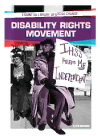
Disability Rights Movement PDF
Preview Disability Rights Movement
ESSENTIAL LIBRARY OF SOCIAL CHANGE by Tim McNeese ESSENTIAL LIBRARY OF SOCIAL CHANGE ESSENTIAL LIBRARY OF SOCIAL CHANGE by Tim McNeese Content Consultant William N. Myhill Director of Legal Research and Writing Burton Blatt Institute, Syracuse University CREDITS Published by ABDO Publishing Company, PO Box 398166, Minneapolis, MN 55439. Copyright © 2014 by Abdo Consulting Group, Inc. International copyrights reserved in all countries. No part of this book may be reproduced in any form without written permission from the publisher. The Essential Library™ is a trademark and logo of ABDO Publishing Company. Printed in the United States of America, North Mankato, Minnesota 052013 092013 Editor: Melissa York Series Designer: Emily Love Photo credits: Rich Peroncelli/AP Images, cover, 2; Evans/Three Lions/ Getty Images, 6, 55; Bettmann/Corbis/AP Images, 8, 41, 47, 66, 78; Mark J. Terrill/AP Images, 12; North Wind Picture Archives, 14, 21; Stock Montage/ Getty Images, 18; Jerry Cooke/Time & Life Pictures/Getty Images, 25, 56; Library of Congress, 26, 29; Lewis W. Hine/Library of Congress, 33; Interim Archives/Getty Images, 35; Jacques Boyer/Roger Viollet/Getty Images, 36; C. F. Chambers/Library of Congress, 38; Sonnee Gottlieb/Hulton Archive/ Getty Images, 48; Donn Brinn/AP Images, 51; Marty Lederhandler, File/AP Images, 62; OR/AP Images, 65; AP Images, 68; Sal Veder/AP Images, 73; Lana Harris/AP Images, 75; Dennis Cook/AP Images, 76; John Prieto/The Denver Post/Getty Images, 81; Jeff Markowitz/AP Images, 85; Melanie Stengel/ Bettmann/Corbis/AP Images, 86; Barry Thumma/AP Images, 89; iStockphoto/ Thinkstock, 92; Mel Evans/AP Images, 97; Red Line Editorial, 100, 101 Library of Congress Control Number: 2013932965 Cataloging-in-Publication Data McNeese, Tim. Disability rights movement / Tim McNeese. p. cm. -- (Essential library of social change) Includes bibliographical references and index. ISBN 978-1-61783-886-6 1. People with disabilities--Civil rights--Juvenile literature. 2. Discrimination against people with disabilities--Legal status, laws, etc.--United States-- Juvenile literature. I. Title. 342--dc23 2013932965 contents 1 OVERCOMING DISABILITY ..............................6 2 “LASHED INTO OBEDIENCE” ..........................14 3 THE RISE OF DISABILITY INSTITUTIONS .........26 4 “JOBS, NOT TIN CUPS” .................................36 5 POLIO, WAR, AND NEW VIEWS .................... 48 6 THE INDEPENDENT LIVING MOVEMENT ....... 56 7 ACTIVISTS AND SECTION 504 .......................66 88 THE ADA: THE CAMPAIGN BEGINS ............... 76 9 A NEW FUTURE FOR PEOPLE WITH DISABILITIES ...................................... 86 TIMELINE ......................................................98 ESSENTIAL FACTS ...........................................100 GLOSSARY ...................................................102 ADDITIONAL RESOURCES ..................................104 SOURCE NOTES ..............................................106 INDEX ..........................................................110 ABOUT THE AUTHOR AND CONSULTANT .................112 CHAPTER 1 OVERCOMING DISABILITY T wenty-year-old Robert L. Burgdorf Jr. was ready for work and could not have been more proud. The year was 1968, and young Bob was home from college for the summer. He hoped to soon be walking in his father’s footsteps. Robert Sr. was a longtime electrician and a member of a union in Evansville, Indiana. That summer, the union was sponsoring a special program allowing young men to work as apprentices with their 6 Before the 1970s, people with disabilities were frequently segregated in the workforce. fathers or other professional electricians. Young Bob was prepared for his first day on the job as a summer student assistant. He suited up in his father’s typical work uniform: jeans and a T-shirt, a hard hat, and an electrician’s belt bristling with tools, “slung low over my hip like a holster.”1 He certainly looked the part of an electrician. In fact, he reminded himself of his father. Robert Burgdorf Sr. had helped prepare his oldest son for this special day. He had familiarized his son with the tools of his trade. And now father and son could work together. Excited about his first day on the job, young Bob “felt adult and manly.”2 But that first day, and all it represented for the son of an Evansville electrician, would soon turn to disappointment. As the sons gathered at the local union hall with their fathers, the foreman soon spotted young Bob. He immediately took him aside and told him he would not be needed. With a matter-of-fact tone, he said words that cut the young man to the heart: “We’re not hiring any cripples here.”3 For nearly 20 years, Bob Burgdorf Jr. had lived with a physical challenge. When he was only months old, he contracted childhood polio. The disease left his right arm paralyzed. At the time, there was no cure for the disease. His parents recalled how their milkman, who delivered 7 Many polio survivors required crutches, leg braces, or wheelchairs. milk to their door, stopped coming to their house for fear of getting the disease. Yet the elder Burgdorf had not allowed his son to use his condition as an excuse. He had drilled into young Bob the belief he could do anything he put his mind to. His son had taken the lessons to heart, learning to do things with 8
